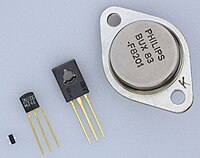
Photo from wikipedia
The conduction modes of the quadratic boost converter are explored in the context of high-dc-gain applications. A complete analytical description of the steady-state behavior of the converter operating in four… Click to show full abstract
The conduction modes of the quadratic boost converter are explored in the context of high-dc-gain applications. A complete analytical description of the steady-state behavior of the converter operating in four possible inductor current discontinuous-conduction modes is presented. Boundaries between modes are determined together with the corresponding transitions. The study covers the operation of the converter using a pulse width modulator for constant switching frequency, and employing a hysteresis comparator for variable switching frequency. Both cases are analyzed for the same set of converter parameters and different constant resistive loads, while the converter is fed by a low dc voltage ranging from 20- to 30-V dc. Several simulations are used to verify the waveforms and average values predicted by the theoretical analysis. Experimental results in a 60-W prototype are in good agreement with the theoretical predictions, and efficiency measurements reveal that one of the discontinuous-conduction modes can compete with the continuous-conduction mode in high-dc-gain applications.
Journal Title: IEEE Transactions on Power Electronics
Year Published: 2017
Link to full text (if available)
Share on Social Media: Sign Up to like & get
recommendations!